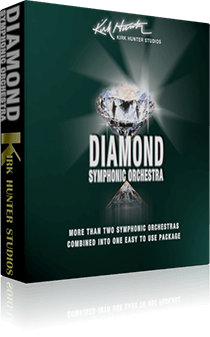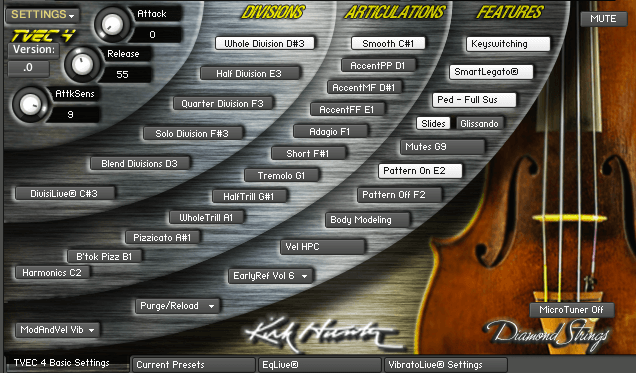
(47 Downloadable Files)
Simple to Use with Realistic Performance Features
TVEC2 TVEC3 and TVEC4 Instruments
Diamond Symphonic Orchestra has several features to aid realistic performance, including:
IntervaLive® – this is used for legato notes. Raising or lowering the pitch wheel (TVEC2) triggers manufactured release samples that bend up or down to lead into the target note. Used full-bore, the effect is almost portamento; used more subtly it just adds a realistic transition between two notes. The farther you move the pitch wheel, the louder the transition effect. You can also dial the amount of bend up or down using on-screen controls.
Human Pitch Correction or “HPC” – Notes start a little out and then gradually adjust, simulating what real players do. You can control the amount of this effect.
Keyswitches – These are labelled very clearly and are consistent across all instruments. If you want to tweak the attacks, basic controls are provided. The mod wheel always controls volume, unless it’s set up to control vibrato; beyond that, velocity, and the pitch wheel-controlled transitions.
This library sounds very realistic and doesn’t sound artificially clean – an effect that Kirk Hunter have cultivated very carefully. This is a great sounding orchestra and it has solo string programs to die for!
Flexible Ensembles For The Ultimate Control!
The “Diamond Symphony Orchestra”library covers all the standard orchestral instruments, with very large “Concert” string sections (36 tutti vns, 18 1sts, 18 2nds,10 vas, 9 vcs, 6 bss), large “Symphonic” Strings (24 tutti vns, 10 1sts, 10 2nds, 16 vas, 12 vcs, 6 bss), (smaller “Studio” string sections (9-9-6-5-3), and both chamber (4-4-3-2) and solo strings.
Similarly, the brass is available in Concert ensembles of four trumpets, horns, and trombones; three bass trombones; and two tubas; Symphonic ensembles of 6 Trumpets, 6 French Horns, 5 Trombones, 3 Bass Trombones, 2 Tubas (the bass bones and tubas being the same as in “Concert” brass); and also Studio brass; two each trumpets, horns, and tenor trombones, and tuba; and solo instruments. Both muted and unmuted versions of the strings and brass are included.
The winds – including alto flute and contrabassoon—are available in solos and/or some duets. Finally, there’s orchestral percussion, celesta, harpsichord, and a piano.
You can also load lighter versions of all the instruments, and individual articulations are available. Finally, there are ensemble programs – all the strings on one keyboard, for example. Rather than having you load up all the instruments and use up lots of polyphony for these programs, there are sets of “Bonus” programs made up of combined sections that have been merged into one set of samples.
![dia_gui_tvec4[1]](https://www.kirkhunterstudios.com/wp-content/uploads/2016/03/dia_gui_tvec41.png)
![dia_gui_tvec[1]](https://www.kirkhunterstudios.com/wp-content/uploads/2016/03/dia_gui_tvec1.png)
The Key Features of “Diamond Symphony Orchestra”
- 45GB of samples covering all the standard orchestral instruments.
- 1 mic position and up to 4 dynamic layers per note
- “Concert” string sections, large “Symphonic” Strings, smaller “Studio” string sections plus both chamber (4-4-3-2) and solo strings.
- “Concert” brass ensembles, “Symphonic” brass ensembles and also “Studio” brass.
- The winds – including alto flute and contrabassoon are available in solos and/or some duets.
- Both muted and unmuted versions of the strings and brass are included.
- Also included are orchestral percussion, celesta, harpsichord, and a piano.
- Lighter versions of all the instruments, and individual articulations are available.
- IntervaLive® – for smooth legato passages.
- Human Pitch Correction or “HPC” – simulates the way real players start notes slightly out of tune.
- Keyswitches are clearly labelled and are consistent across all instruments.
How Exactly Are the Instrument Sections Divided?
The instruments and instrument sections in Diamond Symphony Orchestra are divided logically into divisions, ensembles and solo instruments. Easily move through different divisions and articulations with simple interface key switching
1st and 2nd Violins
- Whole Division – 18 Violins
- Half Division – 9 Violins
- Quarter Division – 4 Violins
- Solo Division – Solo Violin
Violas
- Whole Division – 10 Violas
- Half Division – 6 Violas
- Quarter Division – 4 Violas
- Solo Division – Solo Viola
Basses
- Whole Division – 5 Basses
- Half Division – 3 Basses
- Quarter Division – 2 Basses
- Solo Division – Solo Bass
Combinations:
- Whole Division – 43 players
Additional ensembles:
- Concert” Strings (36 tutti vns, 18 1sts, 18 2nds,10 vas, 9 vcs, 6 bss)
- “Symphonic” Strings (24 tutti vns, 10 1sts, 10 2nds, 16 vas, 12 vcs, 6 bss)
- “Studio” strings (9 tutti vns, 9 1sts, 9 2nds, 6 vas, 5vcs, 3bss)
- “Chamber” strings (4 1sts 4 2nds, 3 vcs, 2)
- “Solo” strings (1 1st, 1 2nd, 1 va, 1 vc, 1 bss)
- Muted and unmuted versions of all of the above
- Velocity-sensitive marcato, marcato, legato, adagio, detaché, sforzando, pizz, trills, tremolo and more.
Brass:
French Horns
- Whole Division – 6 FH
- Half Division – 4 FH
- Quarter Division – 2 FH
- Solo Division – Solo FH
Trumpets
- Whole Division – 6 Trumpets
- Half Division – 4 Trumpets
- Quarter Division – 2 Trumpets
- Solo Division – Solo Trumpets
Trombones
- Whole Division – 8 Trombones
- Half Division – 4 Trombones
- Quarter Division – 2 Trombones
- Solo Division – Solo Trombones
Tuba
- Solo Tuba
Additional ensembles:
- “Concert” ensemble (4 trumpets, 4 horns, 4 trombones; three bass trombones; and two tubas)
- “Symphonic” ensemble (6 Trumpets, 6 French Horns, 5 Trombones, 3 Bass Trombones, 2 Tubas)
- “Studio” brass; (2 trumpets, 2 horns, 2 tenor trombones, 2 tuba)
- Muted and unmuted versions of all of the above
- Velocity-sensitive marcato, marcato, legato, adagio, detaché, sforzando, pizz, trills, tremolo and more
Orchestral Percussion:
- Harp
- Timpani
- Piano
- BassDrum,Gong,Snares,Toms
- CrashCymbals
- Tambourine
- Sleigh bells
- Gong
- Snares
- Suspended Cymbals
- Xylophone
- Glockenspiel
- Harpsichord
- Tubular Bells
- Celesta
Woodwinds:
- Woodwind combinations
- Piccolo
- Flutes
- Alto Flute
- Oboe
- English Horn
- Clarinet
- Bass Clarinet
- Bassoon
- Contra Bassoon
- Additional full combinations
Besides the various and deep programming features of each library,
Concert Strings 3 - You can create sections ranging in size from 4 - 16 players. You can control EACH player's volume, panning. Instruments are programmed for medium to larger ensemble sounds. Full vibrato control.
Chamber Strings 3 - You can create sections ranging in size from 2 - 4 players. You can control EACH player's volume, panning. Instruments are programmed for smaller ensemble sounds. Full vibrato control.
Spotlight Solo Strings - You can create sections ranging in size from 1 - 4 players. You can control EACH player's volume, panning. Instruments are programmed for a soloist sound. There is a bonus "ripieno" feature that allows you to add an ensemble behind the soloists. Full vibrato control.
Concert Strings 2 - You can choose 4 different section sizes - "Whole", "Half", "Quarter", and "Solo". Recorded in a rather "dry" space. Includes Easy String Arranger programming.
Pop Rock Strings - Created from the most usable samples of Concert Strings 2. You can choose 4 different section sizes - "Whole", "Half", "Quarter", and "Solo". Recorded in a rather "dry" space. Programmed for more "pop" and "rock" music. Includes Easy String Arranger programming.
Concert Brass 2 - You can choose 4 different section sizes - "Whole", "Half", "Quarter", and "Solo". Recorded in a rather "dry" space. More "elegant" and "round" than the brass in Diamond.
Diamond - Two (2) string and brass orchestras with included woodwinds and percussion. (Included Concert Strings Legacy) For strings and brass, you get "Symphonic" and "Concert" for larger sections, "Studio" and "Chamber" for smaller sections, and "Solo". In newer programming (TVEC3, TVEC4) you can choose 4 different section sizes - "Whole", "Half", "Quarter", and "Solo". Most samples were recorded in a large space.
Solo Strings 1 - Included in Diamond.
Solo Strings 2 - Included in Concert Strings 2. Samples have more velocity layers and notes than in Solo Strings 1.
- 45GB disk space
- Kontakt 5.7.1 - or newer. Must be the FULL version of Kontakt, not the free player version.
- This library does NOT require the "Add Library" or authorization process.
- Once these libraries are discontinued, their download links will no longer be available so PLEASE make a backup after you download.
TVEC 4 for Strings(Same TVEC 4 tutorial as Concert Strings 2)
TVEC 4 for Brass(Same TVEC 4 tutorial as Concert Strings 2)








The Diamond Orchestra is a great sounding library with key switches and articulations that are different and stunning.The ability to choose 4 different section sizes in one patch is simply marvellous….with the option of running the samples dry with no efx is a big plus that makes them pliable in many scenarios!
Use it. Love it. Highly recommend it, every if you have other orchestral libraries!
a super library,wich contains everything orchestral you need
with a lot of articulations,many more then certain libraries
the sounds are very realistic and maniable
Sept 15, 2016 .I bought this library a month ago . I needed something to add to my arsenal. I own Garritan GPO,GPO5,and Instant, Albion One,Kontakt5,ProjectSam OE . I was looking for something different .
I found Diamond Orchestra totally different with all the keyswitch articulations are just fabulous.The Trombones ,French Horns Trumpets,are so realistic without EQ or Masking the sound with efx.The Malleted cymbals are my favorite,realistic and the Timp rool articulation to.The strings are satisfactory.Woods are good.I will be using this library in my scores .I bought this at a Sale on VST Buzz for $115.00.What a deal!
This biggest challenge is to find an orchestra library that matches this quality at this price. A very underrated orchestra.
I keep coming back to these sounds, even after trying so many other sample libraries, these just have the bar set above. The concert strings, the chamber legato into M7 scoring stage IR and boom! nothing sounds better. Nothing. some of the best woodwind recording styles too. LASS, EW should buy this just to learn how to record a decent sample…. Nothing is more important then sample quality itself to me, the room, the mics, the players, the pre amps, these guys nail it!